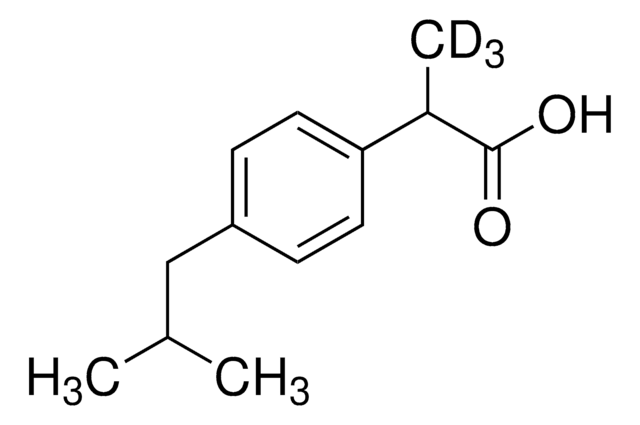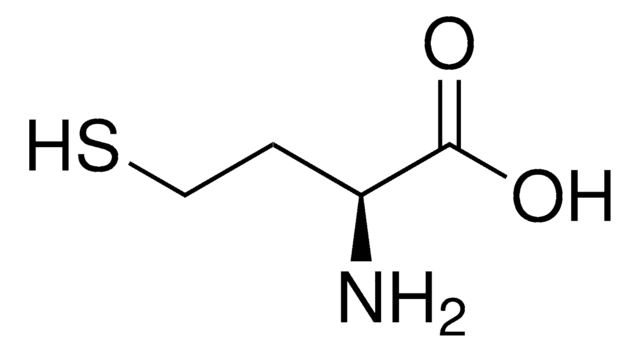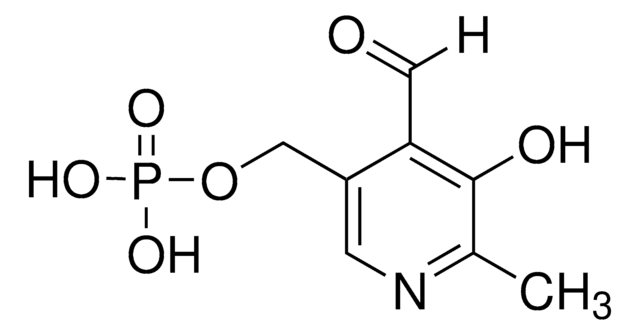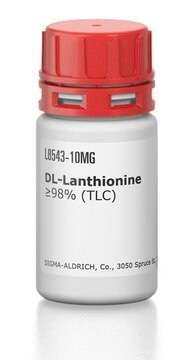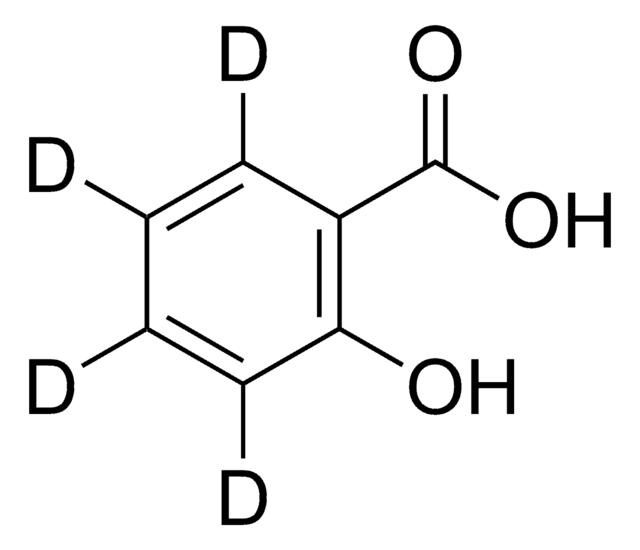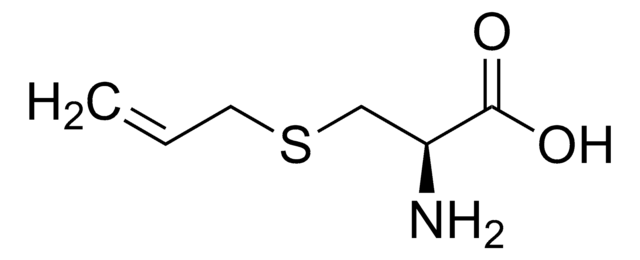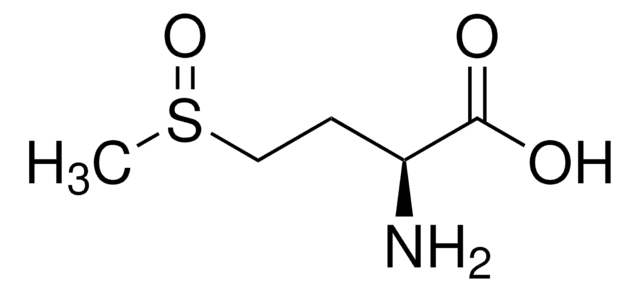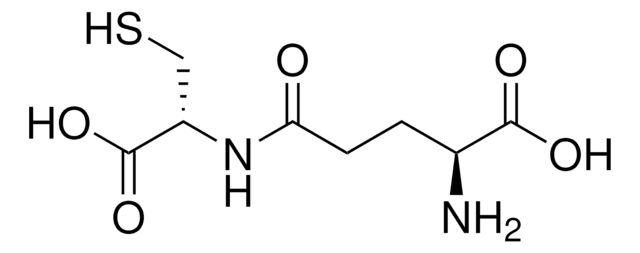M6626
S-Methyl-L-cysteine
suitable for ligand binding assays
Synonym(s):
(R)-2-Amino-3-(methylmercapto)propionic acid, SMLC
Sign Into View Organizational & Contract Pricing
All Photos(3)
About This Item
Linear Formula:
CH3SCH2CH(NH2)CO2H
CAS Number:
Molecular Weight:
135.18
Beilstein:
1721675
EC Number:
MDL number:
UNSPSC Code:
12352209
eCl@ss:
32160406
PubChem Substance ID:
NACRES:
NA.26
Recommended Products
Product Name
S-Methyl-L-cysteine, substrate for methionine sulfoxide reductase A
Quality Level
form
powder
technique(s)
ligand binding assay: suitable
application(s)
peptide synthesis
storage temp.
−20°C
SMILES string
CSC[C@H](N)C(O)=O
InChI
1S/C4H9NO2S/c1-8-2-3(5)4(6)7/h3H,2,5H2,1H3,(H,6,7)/t3-/m0/s1
InChI key
IDIDJDIHTAOVLG-VKHMYHEASA-N
Looking for similar products? Visit Product Comparison Guide
Application
- In-vitro antioxidant and anti-inflammatory potential along with p.o. pharmacokinetic profile of key bioactive phytocompounds of Snow Mountain Garlic: a comparative analysis vis-à-vis normal garlic.: This study examines the antioxidant and anti-inflammatory properties of S-Methyl-L-cysteine found in Snow Mountain Garlic, providing insights into its potential therapeutic applications (Kaur et al., 2024).
- Acidification and tissue disruption affect glucosinolate and S-methyl-l-cysteine sulfoxide hydrolysis and formation of amines, isothiocyanates and other organosulfur compounds in red cabbage (Brassica oleracea var. capitata f. rubra).: The research highlights how acidification and tissue disruption influence the hydrolysis of S-Methyl-L-cysteine sulfoxide, impacting the formation of various bioactive compounds in red cabbage (Hanschen, 2024).
- Selective cycloaddition of ethylene oxide to CO(2) within the confined space of an amino acid-based metal-organic framework.: This research explores the use of an S-Methyl-L-cysteine-based metal-organic framework for the selective cycloaddition of ethylene oxide to CO2, demonstrating its potential in green chemistry and materials science (Bilanin et al., 2023).
Biochem/physiol Actions
S-Methyl-L-cysteine (SMLC) is a substrate in the catalytic antioxidant system mediated by methionine sulfoxide reductase A (MSRA). SMLC is naturally present in garlic, cabbage, and turnips and has been studied as a theurapeutic for neurodegenerative diseases including Parkinson′s.
When used as a dietary supplement in the Drosphilia model of PD, SMLC increases the efficacy of the MRSA catalytic antioxidant system by providing additional substrate available leading to increased resistance to oxidative stress.
When used as a dietary supplement in the Drosphilia model of PD, SMLC increases the efficacy of the MRSA catalytic antioxidant system by providing additional substrate available leading to increased resistance to oxidative stress.
Storage Class Code
11 - Combustible Solids
WGK
WGK 3
Flash Point(F)
Not applicable
Flash Point(C)
Not applicable
Personal Protective Equipment
dust mask type N95 (US), Eyeshields, Gloves
Choose from one of the most recent versions:
Already Own This Product?
Find documentation for the products that you have recently purchased in the Document Library.
Customers Also Viewed
Maximilian J Helf et al.
Chembiochem : a European journal of chemical biology, 18(5), 444-450 (2016-12-15)
Amino acid modifications are essential for the structural diversity and bioactivity of ribosomally synthesized and post-translationally modified peptide natural products (RiPPs). A particularly large and virtually untapped pool of unusual RiPPs and associated modifying enzymes is provided by uncultivated bacteria.
Methionine sulfoxide reductase A and a dietary supplement S-methyl-L-cysteine prevent Parkinson's-like symptoms.
Wassef, R. et al.
The Journal of Neuroscience, 21, 12808-12816 (2007)
Ashis K Patra et al.
Journal of inorganic biochemistry, 101(2), 233-244 (2006-11-07)
Ternary S-methyl-L-cysteine (SMe-l-cys) copper(II) complexes [Cu(SMe-L-cys)(B)(H(2)O)](X) (1-4), where the heterocyclic base B is 2,2'-bipyridine (bpy, 1), 1,10-phenanthroline (phen, 2), dipyridoquinoxaline (dpq, 3) and dipyridophenazine (dppz, 4), and X is ClO(4)(-) (1-3) or NO(3)(-) (4), are prepared and their DNA binding
Cheng-chin Hsu et al.
The Journal of nutrition, 134(1), 149-152 (2004-01-06)
Balb/cA mice were used to study the in vivo effect of N-acetyl cysteine, S-allyl cysteine, S-ethyl cysteine, S-methyl cysteine and S-propyl cysteine, all derived from garlic, on glutathione (GSH) concentration and catalase and glutathione peroxidase (GPX) activities in plasma, kidney
Ohki Higuchi et al.
Journal of agricultural and food chemistry, 51(24), 7208-7214 (2003-11-13)
Sulfur-containing compounds contributing to health promotion in Allium species are produced via enzymic and thermochemical reactions. Sulfur-containing amino acids and volatile organosulfur compounds were prepared for an antioxidative assay. The inhibitory activity of S-alk(en)yl-l-cysteines and their sulfoxides, volatile alk(en)yl disulfides
Our team of scientists has experience in all areas of research including Life Science, Material Science, Chemical Synthesis, Chromatography, Analytical and many others.
Contact Technical Service
